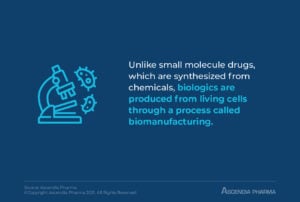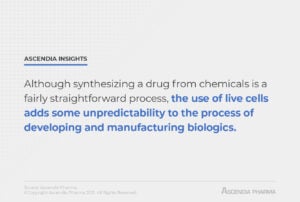Accelerating the Biologics Development Process
As we’ve recently witnessed with COVID-19 vaccines, the process of developing new drugs can be swift with adequate funding, support, and interest. Unfortunately, for the average small molecule drug and biologic, going from development to deployment in under a year is a pipe dream. The biologics development process, in particular, has a number of obstacles that can cause bottlenecks and impact speed to market.
The Biologics Development Process
Although there will always be a market for traditional small molecule drugs, there’s an increasing shift to biologics, or drugs that are manufactured in, extracted from, or semi-synthesized from biological sources. Such drugs are more complex and costly to develop and manufacture, but these obstacles also serve as a barrier to entry for makers of generics, making the development of biologics a worthwhile investment for major pharmaceutical companies.
Even though each step of the development process is more complicated with biologics, the steps are the same. Once a therapeutic protein is identified, a biologic must go through four phases of clinical research. While the initial stages of clinical research are occurring, formulation studies are being performed to determine the best way to deliver a drug to a patient. After final approval is received and a final formulation has been chosen, the development process shifts to scaling up for manufacturing.
Biologics Manufacturing
Biologics are manufactured through a process called biomanufacturing; unlike small molecule drugs, which are synthesized from chemicals, biologics are produced from living cells. The process begins by manipulating a single cell to make it produce the desired protein; once this is successful, the cell will multiply, creating a production cell line. The production cell line is transferred to a bioreactor, which has optimal conditions and nutrients for these cells to continue multiplying. When cells are collected from a bioreactor, they must be frozen in vials to ensure stability.

The next step in the biologics development process is taking a frozen vial of cells from a cell bank, thawing it, and transferring it into a larger bioreactor. As cells continue to multiply, they are transferred to bigger bioreactors to accommodate the larger populations. Cells are carefully monitored for viability, contamination, and product concentration. It should also be noted that biologic manufacturing must be aseptic, which requires following strict protocols that reduce the risk of contamination at any point in the process.
Once the final bioreactor has reached full capacity, the so-called “downstream” process begins. The proteins are harvested, which involves first separating the cells from the liquid growth medium, then separating the therapeutic protein from other proteins using column chromatography.
Column chromatography is a purification method that separates targeted proteins based on their electrical charge, structure, or size. Proteins pass through a column that uses solid resin to catch proteins; the desired proteins are captured by the column, then washed off and collected for further purification.
Next, the biologic is formulated; the therapeutic protein is combined with inactive ingredients (excipients) and preservatives for increased stability. The biologic is then filled, labeled, packaged, and shipped.
Challenges in Developing Biologics
Synthesizing a drug from chemicals is a fairly straightforward process, but the use of live cells adds some unpredictability to the process of developing and manufacturing biologics. To accelerate the biologics development process, we must first understand the challenges that must be overcome.

Formulation
It’s common for small molecule drugs to be available in a number of different forms. The same drug may be available as a liquid suspension for kids, tablets or capsules for adults, and an injection for hospital use. When it comes to biologics, injection is the primary means of administration because of its molecular structure and instability.
Even as an injectable, there are some additional formulation challenges with biologics. In a vial or prefilled syringe, biologics may be vulnerable to protein aggregation. Biologics are sensitive to light and temperature, so they are usually lyophilized, then kept frozen to maintain their physical stability during shipment and storage.
Manufacturing
As mentioned above, the aseptic manufacturing process adds costs and complexity to manufacturing biologics. Because terminal sterilization is not an option for biologics, every step of the manufacturing process must be strictly controlled and monitored. Filtration is used to ensure purity, but filtration also increases the risk of degradation.
Safety
Biologics typically require aseptic manufacturing because they don’t have the stability to withstand autoclave sterilization at the end of the manufacturing process like small molecule drugs. When contamination is found, it can mean millions of dollars in losses for a pharmaceutical company, along with potential downtime in manufacturing, which can lead to shortages.
With current Good Manufacturing Practices (cGMP) guidelines and regular testing throughout the manufacturing process, it’s rare that a contaminated drug makes its way into the hands of patients. The high bar set for safety presents more of a challenge in terms of the expense and work involved in compliance and the financially disastrous consequences that occur when contamination is identified.
Expedited Drug Development for Biologics
A shortened development time for biologics isn’t just about speed to market or maximizing profits—it can save lives. Partnering with a CMO is one way to expedite the process, as a CMO with experience in biologics already has the personnel and equipment needed on-site.

Another method of ensuring that the biologic development process runs at optimal speed is through process characterization, which involves determining acceptable ranges for different parameters to enable more consistency in the manufacturing process. As an example of this, AbbVie has a five-step process for accelerating biologics manufacturing through process characterization:
1. Master Plan
This is a document that describes the manufacturing process of a biologic from beginning to end, and details how current Good Manufacturing Practices will be carried out. A master plan should be logical, justifiable, and comprehensive.
2. Risk Assessments
Risk assessments should be performed on certain product quality attributes and process characteristics; once this is carried out, a list of parameters to be evaluated should be made and ordered according to priority.
3. Cell Culture and Purification Process
Process characterization for this point in manufacturing involves laboratory scale-down models, process mapping, Proven Acceptable Range (PAR) studies to determine the impact of variations in operating parameters, in-process sample stability, and impurity clearance.
4. Post-Characterization Risk Assessment
Once data has been gathered from process characterization, additional risk assessments should be performed on the process parameters. This will result in a ranked list of critical parameters, as well as those that are not critical.
5. Process Justification
This report provides a justification for the proven acceptable ranges chosen for the operating parameters and summarizes the control strategy for manufacturing.
As the market for biologics grows and the number of these drugs increases, we can expect acceleration in development by virtue of the fact that manufacturers will have more experience and knowledge to draw from with each subsequent drug. Already, facilities are taking a faster, less expensive modular approach with single-use equipment, selecting clonal cell lines with shorter doubling times, improving the filtration process, and investing more in quality control to prevent delays caused by manufacturing bottlenecks.
How Long Does Accelerated FDA Approval Take?

Much of the conversation about increasing the speed to clinic for biologics involves accelerating the drug approval process. The FDA has four options for accelerated approval:
1. Priority Review
Priority review means the FDA plans to take action on an application within six months. These drugs should represent an improvement in the safety or effectiveness of the diagnosis, treatment, or prevention of a serious health condition.
2. Breakthrough Therapy
This process expedites the development and review of drugs that represent a significant improvement over currently available therapies.
3. Accelerated Approval
Accelerated approval is an option for drugs that fill an unmet need when it comes to treating serious health conditions.
4. Fast Track
Fast track approval facilitates the development of drugs for serious health conditions and expedites the review process.
On average, a drug in any of these four programs will reach market almost a year earlier than other drugs that do not have expedited reviews.
In addition to these programs, the FDA also offers an expanded access program for biologics. This program allows patients who are not eligible for clinical trials to access experimental biologics to treat serious health conditions when there is no other approved alternative available. Although this doesn’t impact speed to market, it does improve speed to patient for potentially life-saving therapies.
Partnering with Ascendia for Rapid Development
At Ascendia, we accelerate the biologics development process for discovery-stage pharmaceutical companies by providing lab-scale formulations for pre-clinical testing. Our team of researchers can also perform pre-formulation assessments, bioavailability modeling, and formulation approach comparisons. We provide cGMP formulations for Phase I clinical trials, as well as materials suitable for animal studies and toxicology studies as part of our rapid development process.
Our partners find that working with Ascendia helps them get their biologics to market sooner thanks to our rapid, cost-effective formulation technology screening services and nano-particle technology platforms. We help our clients determine the feasibility of a number of different approaches in parallel, improving the odds of a successful formulation and reducing the time and costs needed in early-stage formulation. Because our technologies are well-established in the pharmaceutical industry, we can quickly move to registration batches without any concerns about regulatory approval regarding our biological formulation development process.
Learn More About Expedited Drug Development
Contact us today to discuss your biologics development needs.

